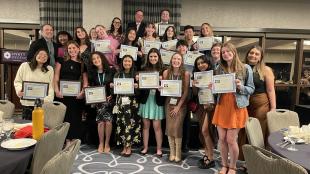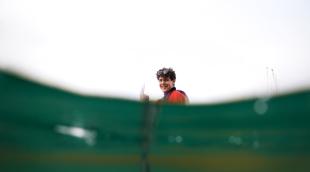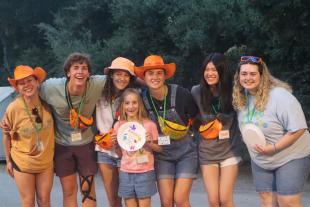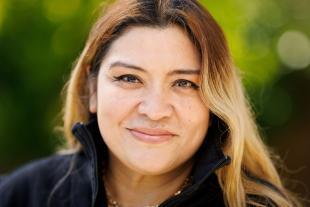Meet Six Great Grads from Cal Poly's Class of 2018
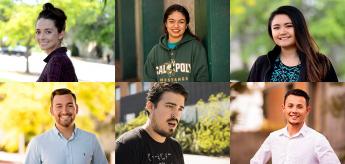
Cal Poly ends its academic year each June with a heartfelt goodbye to thousands of graduates who will soon begin careers or continue on with advanced studies and address the world’s problems with innovation, creativity and confidence earned through their Learn by Doing education.
Each graduate has a unique story of success and perseverance, along with thoughts on how their university experience has shaped them as they prepare to make their way in the world. Meet six outstanding members of the Class of 2018:
Alexandrea "Mickey" Guerra
College of Agriculture, Food and Environmental Sciences
Mickey Guerra, who’s love of agriculture was cultivated amid the furrows and folds of Santa Maria Valley, wants to help a new generation of farmers and ranchers.
“To me, growing up on a ranch surrounded by animals, crops and deciduous trees was all I knew,” the Orcutt resident said. “My home became the backbone of the person I am today.
“Now, I am working on taking the knowledge and skills I learned in the agriculture industry and developing it into a career, because I am driven by the idea of being a leader.”
The agriculture science major, with a concentration in plant and soil science, attended area schools — Righetti High School’s Class of 2010 and Allan Hancock College, where she obtained an associate arts degree in agriculture and general studies in 2012.
“I made the decision to earn my degree in agriculture education, because I have the drive to teach the 79,512-and-growing agriculture students in our state about the potential to be tomorrow’s leaders in the industry,” said Guerra, 25. “I want to be able to leave behind a legacy of inspiration.”
Being a commuter student and a mother who also worked part-time as a program technician with the U.S Department of Agriculture, Guerra had numerous challenges in pursuit of her degree. But she also found inspiration along the way in the eyes of her 5-year-old son.
“Making the 45-minute commute to and from school had its ups and downs, but I knew that it was something I had to do to accomplish the goals I had set for myself,” she said. “This past year, I was able to bring along my son, Jax, as he started preschool on campus with the ASI Children’s Center. Watching him become a little gentleman and shaping his understanding of just how important an education really is, has been rewarding.”
When looking to pursue her education, the choice was obvious. Agriculture has been one of the cornerstones of a Cal Poly education, harkening to its roots more than 100 years ago as a polytechnic school for boys and girls.
“A Cal Poly degree runs in my family,” Guerra said. “I wanted to stay close to home, and I always aspired to pursue an education in the Happiest City in America.”
She loved the Learn by Doing approach to education that included hands-on experience in the fields for vegetable, citrus and avocado production as well as time spent operating a tractor “and even making ice cream in dairy manufacturing class,” she said.
She will look back on the friendships forged with her classmates and faculty and her senior group project that was also a near-and-dear effort: “the opportunity to work hands-on with FFA students and elementary students to teach them about the agriculture industry.”
She will return to campus this fall in pursuit of a master’s degree in agriculture education as well as the agriculture credential program as she pursues her dream of becoming a high school ag teacher.
“Cal Poly has impacted me in a way that only a Mustang would understand,” Guerra said. “The school spirit, the experiences and the atmosphere over the past years have shaped who I am today.”
• • •
Ana Padilla
College of Architecture and Environmental Design
Ana Padilla transformed herself at Cal Poly.
As a high school sophomore, she fell in love with the university during a campus visit. Two years later in 2014, she began classes at her “dream school.” In four years, the city and regional planning major went from determined student to campus leader, and on June 17, she will become a college graduate ready to enter the working world as “a progressive participant” of her community.
“I originally was going to apply for architecture, but I found city planning was more of what I wanted,” said the Hacienda Heights resident. “My career goal consists of working with a company or organization that helps neighborhoods for disadvantaged communities.”
She became immensely interested in urban planning concepts through her upbringing and courses. While taking a Study Abroad program during the summer of her second year, Padilla began to apply an interdisciplinary approach to her interests.
“I was granted the opportunity to enter a new architectural program, which allowed me to travel through Central Mexico,” the 21-year-old said. “I am no stranger to Mexico; after all, it is a major part of my family’s heritage. I’ve never looked at it from a city planner’s point of view, though.
“Going there with architects was a completely new challenge that I did not anticipate. I learned how to experiment with design while taking a breath and stepping back and going back to basics.”
The program included a week in the states of Zacatecas, Aguascalientes and Guanajuato, two months in the city of San Miguel de Allende, and finally a week in the sprawling capital, Mexico City.
“Mexico takes a lot of pride in its cities: colorful and innovative architecture; lively public spaces; walkable streets; and plenty of public events with music, elegant plazas and savory food,” she said. “Experiencing Mexico City made me redefine what diversity, complete streets, overcrowding, faith, corporations, a central park, public art, swap meets, community, waste, museums and traffic — lots of traffic — meant to me.
Padilla embraced her college experience by challenging herself “to do everything I could to get a quality and holistic education.”
She was a four-year member of Associated Students in Planning, a club for those interested in urban design and city and regional planning that is associated with the American Planning Association. As a senior, she has represented her College of Architecture and Environmental Design peers on the ASI Board of Directors. And since February of 2017, she has worked as a planning intern at the Caltrans District 5 headquarters in San Luis Obispo, implementing concepts from class and learning more by working.
In addition to her Cal Poly education, Padilla fondly looks back at meeting some amazing people from different places and upbringings.
“I learned early on that the people you surround yourself with and the positions you put yourself in all impact your well-being,” said Padilla, who is narrowing her choices as she readies to begin her planning career. “I tried to surround myself and learn from people who challenged me academically, socially and professionally.
“The experiences I have had with the friends I have made here are absolutely amazing, and I will appreciate that forever.”
• • •
Ariel Crisostomo
College of Engineering
Ariel Crisostomo found her niche as a biomedical engineering major early — while touring Cal Poly as a high school student.
“I had heard of Cal Poly’s hands-on engineering program and wandered into the Quality of Life Plus lab after taking a college tour,” said Crisostomo, who will turn 22 four days before commencement. “I was inspired by all of the meaningful and innovative projects that undergraduates got to work on. I also wanted to be in an area conducive to learning and personal growth, and San Luis Obispo was the perfect college town.”
Quality of Life Plus, or QL+, is a nonprofit headquartered in McLean, Va. It works to generate and foster innovations that improve the quality of life for those injured in the line of duty. Cal Poly houses a major lab, while established QL+ programs also operate at several universities across the nation.
Crisostomo, whose father serves in the Air Force, teamed with four other engineering students to build a “Treadmill Centering Device” to assist an Air Force veteran and blind athlete, Larry Gunter. The device allows him to safely and independently run on a treadmill, while using his full range of motion. Although it was designed specifically for the Georgia resident, who lost his sight due to a genetic disease, the invention has the potential to serve others.
“Working on a QL+ project was a great opportunity to combine the technical engineering skills I’d learned with the passion I’ve had for serving the veteran community,” Crisostomo said. “The scope of this project covers so much more than meeting a physical need — this is Larry’s lifestyle. A product that improves the quality of that lifestyle has emotional, psychological and relational impacts.”
Crisostomo was a founding staff member of the Cal Poly Veterans Success Center, which opened in April 2015. The center is a one-stop shop for veterans and their dependents at Cal Poly, helping them to be successful students and move into their careers. Her duties included representing the center at university and regional events. In 2015, she sang the national anthem during the center’s special military salute to the Sept. 11 anniversary at a non-conference Cal Poly men’s soccer game against Air Force Academy.
Crisostomo was honored for her contributions by being selected from 32 student nominees as Cal Poly’s 2017-18 Outstanding Student Employee of the Year. Her nomination was forwarded to the state and regional competition sponsored by the Western Association of Student Employment Administrators, where she also won state acknowledgment.
Crisostomo also found time — starting in the spring of her freshman year — to serve on the College of Engineering Ambassadors, a high-energy team of students who represent the college by giving tours to industry representatives, alumni, parents and prospective students.
Crisostomo graduated from high school in Las Vegas, Nev. Her family now lives in Vacaville, Calif. After graduation, she will join Penumbra Inc., a Bay Area-based global healthcare company that designs, develops, manufactures and markets medical devices that address challenging medical conditions and significant clinical needs.
“I’m really grateful for the opportunities that Cal Poly has opened up for me, and I’m grateful for having had the chance to give back as well,” she said. “I feel that I’ve learned and grown so much in every area of my life, and I am proud to have spent such a unique time in my life doing so here.”
• • •
Marcos Ramirez-Santos
College of Liberal Arts
Growing up, psychology major Marcos Ramirez-Santos never thought much about his education.
“Honestly, I never planned on going to Cal Poly, or even college in general,” said the 22-year-old. “At the time, I didn’t have education as a main priority in my life. After a while, I realized the importance of it and the benefits of earning a bachelor’s. Cal Poly was close to home, and I could actually afford it financially on my own.”
At Cal Poly, he found that the Learn by Doing education challenged and prepared him for his goal of pursuing a doctorate in school psychology. He also found caring professors who inspired him.
“My professors changed my perspectives about the importance of education, and they made me feel that I belong here at one of the top universities,” he said. “My professors have become friends and are always updating me on new opportunities with internships, jobs and experiences.”
The Chico, Calif., resident also had financial support from the Cal Poly Cares Program that provides grants to assist struggling students like Ramirez-Santos, who worked 40 hours a week while a full-time student. The grants help offset core expenses — including housing, meals, academic supplies, unplanned emergencies and other various costs.
“My professors were very understanding of my situation of being an independent student who had to work and go to college full-time,” he said. “Even when my professors didn’t have office hours, they always made time to accommodate my schedule. Through them, I was introduced to many jobs and internships that gave me experiences to make me eligible for graduate programs.”
Ramirez-Santos found time to assist others, like himself, whose struggles weren’t just financial, as a member of the Student Diversity Committee for the College of Liberal Arts.
“Being a first-generation college student and being a transfer student as well, when I first got here I felt a little bit lost because I didn’t know where to go or how to get help,” he said. “When I joined the diversity committee I felt a sense of belonging.
“Through this, I have gained insight and experience on learning about mentoring and leadership.”
In addition, he served on the college’s Underrepresented Students Network, a new peer mentoring program for underrepresented students that provides support and advice about on-campus resources.
Upon graduation, he will work full-time as a behavior technician at the Kids Connections Developmental Therapy Center assisting clients diagnosed with autism. The center (with offices in San Luis Obispo, Rancho Cucamonga, Simi Valley and Van Nuys) provides support to children and families to ensure successful integration and participation in community activities that are meaningful to the families as a unit.
And he will pursue graduate degrees in psychology to “work alongside children and teens to prepare them academically, emotionally and mentally for success,” he said.
• • •
Frank Gonzalez
College of Science and Mathematics
Frank Gonzalez still smiles thinking about that day in 2015 when he received his Cal Poly acceptance letter.
“I remember screaming so loudly in excitement that my sister yelled and told me to be quiet,” said Gonzalez, 23, a Merced College transfer student whose goal of obtaining a physics degree began when his family relocated to Los Banos, Calif., from Guadalajara, Mexico, during his junior year of high school.
He overcame language issues — he taught himself English while living in Mexico — and during his senior year at Pacheco High School was inspired to pursue physics thanks to a teacher who was a Cal Poly alum.
At Merced College, Gonzalez started out with lower-division physics and introductory calculus classes, as well as other general education courses. He also found time to tutor classmates in math, from pre-algebra to calculus, and even created the campus’ first science club.
Choosing Cal Poly for physics and mathematics was one of his best decisions, he said.
“I will always remember the very welcoming environment,” said Gonzalez, who hopes to complete a doctorate and become either a senior research scientist at a national laboratory, or a physics professor. “Cal Poly will always remind me of that period of my life when I met my physics family. This institution has provided me with a very solid undergraduate education in physics and with the tools I'll need to succeed, not only in graduate school but in other walks of life as well.”
Cal Poly’s Learn by Doing philosophy challenged him “with hard work in short periods of time.”
“It also made me become more efficient with how I manage my tasks,” he said. “The challenges posed by my classes and labs gave me a good work ethic, which will be indispensable for my future career as a physicist.”
His classes and on-campus jobs grading physics coursework and aiding professors Jennifer Klay and Matthew Mewes as a research assistant were challenging.
“My biggest challenge, though, was the birth of my beloved daughter, Josephine,” he said. “She came into this world during my penultimate quarter at Cal Poly, while I was taking quantum mechanics II, differential geometry and complex analysis. In addition, I was filling out grad school applications and preparing for the GRE (Graduate Record Exam).
“It wasn’t an easy time, but I am happy to say that through the help of my wife, family, friends and my own diligence and hard work, I was able to overcome that demanding period.”
Gonzalez will begin graduate physics studies at Florida State University in Tallahassee in the fall.
• • •
John Franzia
Orfalea College of Business
John Franzia didn’t start out as a business major. “I actually changed my major twice, and then it took me a while to pick a concentration,” said the 22-year-old from Ripon, Calif. “I ended up loving my intro-finance class, and that ultimately made my decision.”
He will begin his career as a risk consultant for financial institutions with Ernst and Young in San Francisco, one of the largest professional services firms in the world and one of the “Big Four” accounting firms.
But, he adds: “I am interested in going back to graduate school. Ultimately, I’d like to help grow companies and be a mentor to developing business leaders. I’d also like to volunteer for nonprofits or work in civil service at some point.”
He chose Cal Poly because of its academic reputation — and because it “is in a great area that encourages having an active and outdoor lifestyle. I’ve never met a person who didn’t love going here.”
Over the past four years, the university has given him the freedom to explore and then fine-tune his interests.
“My freshman year I joined a team of students that won the People’s Choice Award in the architecture school’s Design Village competition,” Franzia said. “That year, I also was on a team that won the Center for Innovation and Entrepreneurship’s Pitch Perfect Competition.
“As a sophomore, I lead a group of students in the American Marketing Association (AMA) to the club’s International Collegiate Conference in New Orleans. In my junior year I studied abroad in Sevilla, Spain, and as a senior I got to be president of AMA and compete in the school’s rodeo through my Principles and Practices of Rodeo class.”
While he served as president of the marketing association — one of the largest groups in the college — he and his peers were “able to grow our membership and change the club’s strategy to focus more on community impact and professional development,” Franzia said. “I also learned a lot about what it means to volunteer and be a mentor to your peers and also how to manage big teams of people.”
He completed several internships during his college career: with the family-owned Bronco Wine Co., the fourth largest wine producer in the U.S.; at Equinix Inc., a multinational firm headquartered in Redwood City, Calif., that is the leading global colocation data center provider by market share; and at Bank of the West, which has more than 600 branches and offices in the Midwest and Western U.S.
While working for Bank of the West, Franzia developed a model to prioritize and solve customer complaints. He helped managers at Equinix analyze sales data and research important accounts; and during his time at Bronco, he got a comprehensive view of the operations side of a large winery.
“It was great to use what I’d learned in school out in the field and then bring those experiences back to the classroom,” Franzia said.
He credits his professors and the Learn by Doing education for preparing him and his peers to be successful in the working world and to become industry leaders and innovators.
“I think the faculty are really focused on preparing students academically and for their careers,” he said. “Cal Poly offers tons of ways to get involved and learn about industry outside of the classroom, through clubs, corporate tours and internships.
“What you can learn inside the classroom is just as important as what you learn outside.”

